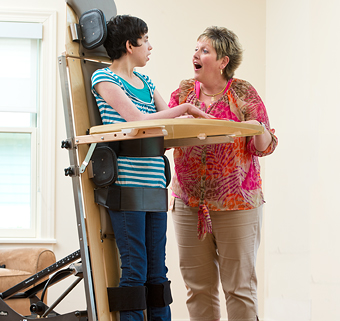Evidence Update: The Effects of Inclination, Hip Abduction, Orientation and Tone on Weight-Bearing in Adaptive Standers
| September 2021 For children with limited ambulation and standing capability, adaptive standers are commonly used to encourage weight-bearing. To date, only two studies describe the use of an adaptive stander for weight-bearing in the pediatric population. Therefore, a great recent study to be aware of is “Inclination, hip abduction, orientation, and tone affect weight-bearing in standing devices.”
For children with limited ambulation and standing capability, adaptive standers are commonly used to encourage weight-bearing. To date, only two studies describe the use of an adaptive stander for weight-bearing in the pediatric population. Therefore, a great recent study to be aware of is “Inclination, hip abduction, orientation, and tone affect weight-bearing in standing devices.”
Although it is a small, exploratory and descriptive study (with fifteen children involved), it is the first to measure weight-bearing during standing in different degrees of hip abduction, stander inclination and stander orientation.
The Study
The children included in the study were between three and nine years old and divided into groups based on muscle tone: high tone, low tone and typical tone. Each child had two opportunities to stand while the amount of weight-bearing through their feet was measured under randomized conditions. The variables in standing conditions were written on index cards and independently selected by the participants beforehand:
- Stander Type: Jenx Stanz; EasyStand Zing; or Prime Engineering HLT Superstand
- Stander Inclination: 0 degrees, 15 degrees or 30 degrees
- Hip Abduction (total): 0 degrees, 30 degrees or 60 degrees
- Stander Orientation: Prone, Supine or upright
Outcomes
Overall, when choosing the best stander conditions to optimize weight-bearing, this study found that muscle tone is a key factor. For the children with high tone, the upright prone position with zero degrees of abduction resulted in the most weight-bearing. In this same group, least weight-bearing occurred in the supine position at thirty degrees of inclination and sixty degrees of abduction. This suggests that maximum positions for incline and abduction should be avoided in children with hypertonia if weight-bearing is the primary goal of stander use.
Conversely, for the children with low and typical tone, increased abduction in the upright supine position resulted in the most weight-bearing. Least weight-bearing occurred in the prone position in thirty degrees inclination with feet together. The chart below provides good visualization of the study’s findings.

There are certainly limitations to this study, as the authors point out. These include the small sample size and measuring weight-bearing through the footplates only. Nevertheless, this pilot study is a first in examining the effects of stander angle, type and abduction on weight-bearing, and therefore a valuable contribution to guide best practices in pediatric therapy intervention.
Reference
Paleg G, Altizer W, Malone R, Ballard K, Kreger A. Inclination, hip abduction, orientation, and tone affect weight-bearing in standing devices [published online ahead of print, 2021 May 28]. J Pediatr Rehabil Med. 2021;10.3233/PRM-190660. doi:10.3233/PRM-190660







